Whether on manicured greens, artificial surfaces or mats, bowls is truly the sport for all. It's easy to learn, affordable, social and FUN! As we say here in Wales:
The Sport For All - The Sport for Life!
There is historical evidence to substantiate that Sir Francis Drake played bowls, but whether the story of Drake finishing a game of bowls at Plymouth Hoe in July 1588, while the Armada was sailing up the British Channel is fact or folklore is not know for certain.
This sport has something for everyone – we’re sure that it will have a lot for you.
The sky is the limit as you enjoy the healthy outdoors on beautiful, green, well-groomed grass. There is no better place to be on a gorgeous spring or summer day or cool summer evening. Or what better way to escape the winter doldrums by playing indoors, on short mat or carpet bowling?
Bowls clubs offer a great place to meet people, and enjoy friendly competition, social events and get-togethers.
Age Group – Bowls caters to everyone from age 5 to 105. There are junior and beginner programs available in most clubs.
There are all kinds of club and local tournaments for people at all levels. Mixed events offer men and women the opportunity to compete in a fun and relaxed environment.
For those who wish to excel in bowls, there is an excellent competitive structure including club, regional, provincial, national, and international events.
Here’s what else participants have to say about the game: "Bowls is..."
The history of bowls, in some form or other, reaches well back into antiquity in various parts of the world, though its actual origin is still a matter of conjecture. Sir Flinders Petrie, the well-known British Egyptologist, reported that during his excavations he found in the grave of a young Egyptian, various rounded objects which led him to believe that they were used for playing with by rolling them along the ground in a game similar to what we now call Bowls. It was established that these . -- over seven thousand years ago. From Egypt it spread to Greece and Rome. The Romans played "Bocci", and that word is still used in Italy today. We can doubtless thank them for introducing the game to England.
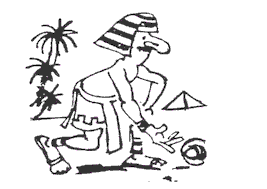
From Egypt bowls spread to Greece and Rome.
Nor is such factual evidence confined to Egypt. Stone Age excavations in other parts of the world have confirmed that some sort of game was played with rounded rocks which were rolled or bowled to a peg or other marker. Among other places, it was played by ancient Aztecs, North American Indians, in China, and in Polynesia.
The ancient Polynesians, particularly in Hawaii, played a game with elliptical bowls, about 10 cm (4 inches) in diameter, fashioned from stone; these were bowled to stone marker discs called Ula, and the game was called Ula Maika. The distance from the bowling area to the discs was about 18 meters (60 feet).
When Captain Cook landed in the Sandwich Islands in 1788, he found that the natives used whetstone for a purpose other than sharpening their tools; they were playing a game with bowls fashioned from the whetstone. "The bowls were about 3 to 4 inches in diameter and about one inch across at the edges but thicker at the centre and rounded very exactly." In his book "Games and Pastimes of the Maori", Elsdon Best refers to some ancient stone discs found on the beach at Tauranga many years ago.
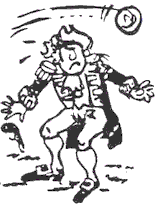
Captain Cook found bowls in the Sandwich Islands
He writes that he could not establish positively the use to which these had been put, but he did say that they resembled those found in Hawaii, though they were slightly larger. He assumed that the Maoris had played with them in a game similar to Ula Maika. At any rate, the shape of these stones is such that when delivered with a normal bowling action, they take bias; that is, they take a curved path, particularly when the initial speed begins to slow down.
These Maori bowls are only a little larger than the composition bowls used today, and they are of a size which could well have enabled them to be used for the same general purpose.
The two oldest British sports are archery and bowls, and in centuries past there was conflict between the two, mainly during periods of warfare or national strife. There is a positive recorded history of bowls having been played in England as far back as the 12th century, and it could well have been played much earlier than that. From the early 15th century bowls were made of wood, usually yew, ash, oak, holly, or boxwood.
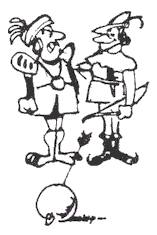
The King was afraid that the practice of archery was being neglected
Lignum vitae was not used in the United Kingdom until the 16th or 17th century; this very hard wood was discovered by Columbus in the West Indies, in 1493. Lignum vitae wood is so heavy that it will sink in water. A separate article could be written on the evolution of the bowl as we know it today. The bowls used in the early days were merely rounded, without bias. The bias was not introduced until 1522 due entirely (it is claimed), to the accidental breaking of a bowl by Charles Brandon, Duke of Suffolk; he rushed indoors and sawed off an ornamental ball from a banister. Accordingly, one part was flat and it took a curving direction at the end of its run, instead of continuing on a straight line.
The increasing popularity of bowls in the 14th century, and the fear by King and Parliament that the practice of archery was being neglected and that the effectiveness of the archers in battle or military operations would therefore be lowered, led to Statutes being passed restricting or forbidding such sports as bowls and tennis: For instance, during the reigns of Edward III in 1361, Richard II in 1388, and Henry IV in1409. However, these Statutes did not prevent the game from being played, and many bowling alleys were opened. In 1511 during the reign of Henry VIII, a Statute was passed confirming previous Acts of Parliament and in 1541, Henry VIII consolidated all earlier Acts and broadened the scope of the prohibitions. (Strangely enough , this 1541 Act was not repealed until 1845, over three centuries later, in the reign of Queen Victoria!). By the Act of 1541 artificers, labourers, apprentices, husbandmen, servants or serving-men, and other "low-born" people, were specifically forbidden from taking part in the game of bowls, except at Christmas in their master's grounds and in his presence. Heavy monetary fines were provided as penalties for non-observance of the Law. However, licenses or permits were granted to some of the larger and more influential landowners to allow them to play on their own greens. In 1555, 14 years later, in the reign of Queen Mary, these licenses were withdrawn on the grounds that the game of bowls was being used as an excuse for "unlawful assemblies, conventicles, seditions, and conspiracies".
There is historical evidence to substantiate that Drake played bowls, but whether the story of Drake finishing a game of bowls at Plymouth Hoe in July 1588, while the Armada was sailing up the British Channel is fact or folklore is not know for certain. But, if he was in fact playing bowls, then Drake was breaking the Law of the Land! There are many references to bowls in Shakespeare: for instance, in Act III of Richard II -- which incidentally indicates that women also played the game at that time.
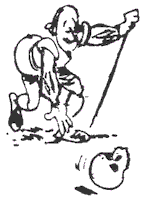
Shakespeare includes bowls in Act III of Richard II
In the 19th century the law banning bowls was apparently largely overlooked. It certainly was not rigorously enforced. Many of the inns had bowling greens, presumably as an amenity to attract custom, and these probably helped the game to survive.
As with golf, the game of Bowls, with more or less the same world-wide Laws, owes its existence to the Scots. Following on a meeting in Glasgow in 1848, attended by about two hundred players from various clubs all with different Laws for playing the game, W.W. Mitchell of Glasgow, drew up a "uniform code of Laws", and these are the basis of all subsequent Laws. In 1892, the Scottish Bowling Association was formed and in 1893, it drew up rules or Laws based on Mitchell's Code and also published a Code of Ethics. In 1903, the English Bowling Association was formed, the first President being Dr. W. G. Grace, who is much more acclaimed and remembered for his fame as a cricketer. The International Bowling Board was formed in 1905, the foundation members being Scotland, England, Ireland, and Wales. New Zealand was first admitted in 1928, as also were Australia, Canada, South Africa, and the United States of America.
The object of the game is to roll the bowl ![]() as close to the white jack
as close to the white jack![]() as possible. The jack is rolled the length of the green to start each end. Where it stops, after being centered in the middle of the rink, becomes the target for the balance of the end.
as possible. The jack is rolled the length of the green to start each end. Where it stops, after being centered in the middle of the rink, becomes the target for the balance of the end.
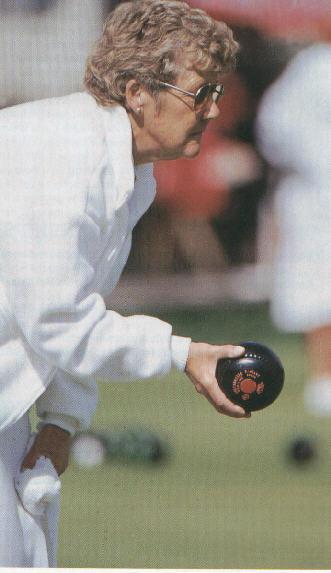
The bowl is not completely spherical, allowing it to curve toward the jack as momentum is lost. The bowl curves either way, depending on which way it is held during delivery.
Bowls involves offensive and defensive strategy to play the game, and has the added challenge that the jack is movable and can be displaced anywhere on the rink by a delivered bowl.
All you need is:
Is 37 to 40 metres square and perfectly flat. The green is divided into rinks, which are not less than 5.5 metres or more than 5.8 metres wide, so several games can be played at the same time. (for your nearest green & club please search through our AFFILIATED CLUBS list)
Includes four (4) bowls, and comes in several sizes to best fit the player’s hand. White, black and brown coloured bowls are most often seen, however brightly coloured bowls are becoming more prevalent. To help distinguish from opponents bowls, coloured decals are often affixed to the bowls.
Bowls Sizes & Weights |
||||
Size Number |
Size Inches |
Size Metric |
Approx Weight Pounds |
Approx Weight Metric |
00 |
4 9/16 |
116 mm |
2 lb. 14 oz. |
1.31 kg |
0 |
4 5/8 |
117 mm |
2 lb. 15 oz. |
1.33 kg |
1 |
4 3/4 |
121 mm |
3 lb. 1 oz. |
1.31 kg |
2 |
4 13/16 |
122 mm |
3 lb. 1 oz. |
1.39 kg |
3 |
4 7/8 |
124 mm |
3 lb. 13/4 oz. |
1.41 kg |
4 |
4 15/16 |
125 mm |
3 lb. 23/4 oz. |
1.44 kg |
5 |
5 |
127 mm |
3 lb. 41/2 oz. |
1.50 kg |
6 |
5 1/16 |
129 mm |
3 lb. 53/4 oz. |
1.53 kg |
7 |
5 1/8 |
131 mm |
3 lb. 63/4 oz. |
1.56 kg |
Is smaller, round and white, and used as the target.
Is 600 mm long and 360 mm wide. One foot must remain entirely within the confines of the mat when a player delivers the bowl.
Flat heel-less footwear, so the greens won't be damaged.
Comfortable clothes which are within the club’s dress standards. This is usually is relaxed and comfortable, with some uniform requirements once you enter higher level competitions.
There are four basic games played:
In Fours there are 4 players per team (2 bowls per player)
In Triples there are 3 players per team (3 bowls per player)
In Pairs there are 2 players per team (4 bowls per player)
In Singles there is one player (4 bowls)
Positions parallel that of curling. In Fours, the team consists of a Skip, Third, Second and Lead, and it is adapted for Triples and Pairs. Each player delivers a bowl alternately with their counterpart until all bowls have been delivered.
This completes one end of play and the shots for that end are counted. One or more points are scored by the team whose bowls are closer to the jack than those of their opponents. One point is scored for each bowl closer.
A game consists of an agreed upon number of ends. In provincial, national, or international play, the number of ends is set. Singles are played to a set number of shots per game (not ends).